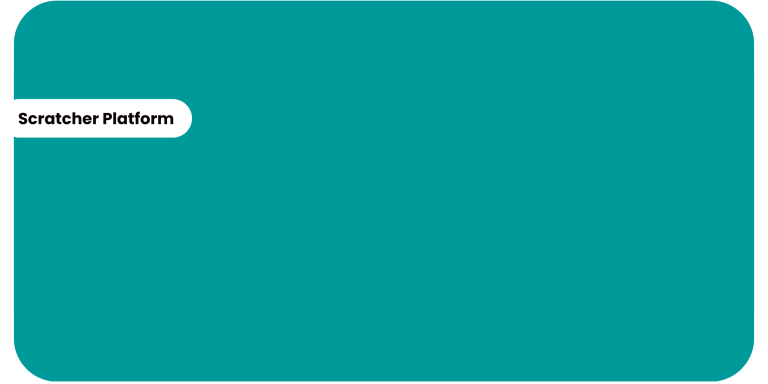Spin the Wheel Guide
Looking to boost engagement, capture leads, and make your marketing campaigns more interactive? The Spin the Wheel game is a proven tactic used by brands across industries to create fun and memorable experiences that drive results.
In this guide, we explore why Spin the Wheel works so well, share real-world examples from successful campaigns, and walk you through how to set one up—from prize configuration to advanced integrations.
Table of contents
- Brief history of “Spin the Wheel”
- Exploration of luck-based games and their psychological appeal
- Various use cases across different industries
- Description of settings and configurations
- Implementation strategies
History of spin the wheel:
(1950s–1980s) Origins in Game Shows & Gambling :
The concept of spinning a wheel for prizes became popular through TV game shows like Wheel of Fortune (1975) and carnival-style games. These formats used randomness and anticipation to entertain audiences and reward participants.
(1990s–2000s) Retail & In-Store Promotions:
Brick-and-mortar retailers began using physical spin-the-wheel setups at events or in stores to drive foot traffic and increase engagement. It became a popular tool for flash giveaways, raffles, and sales events.
(2010s–Present) Digital Transformation & Marketing:
With the rise of digital marketing, “Spin the Wheel” evolved into an online interactive format used on websites and in email campaigns. It gained traction as a gamification strategy for:
- Lead generation
- Customer engagement
- Newsletter subscribers
- Boosting conversions
Why luck-based games like Spin the Wheel work?
Spin-the-wheel games tap into basic human psychology.
They create excitement by combining chance, anticipation, and the possibility of an instant reward. The unpredictability triggers dopamine release—the brain’s “feel good” chemical—making the experience enjoyable and encouraging users to engage repeatedly.
Plus, players feel a sense of control when they spin, even though the outcome is random. This “illusion of control” motivates participation and boosts satisfaction. That’s why spin-the-wheel mechanics are so powerful in marketing—they make users excited, curious, and more likely to take action.
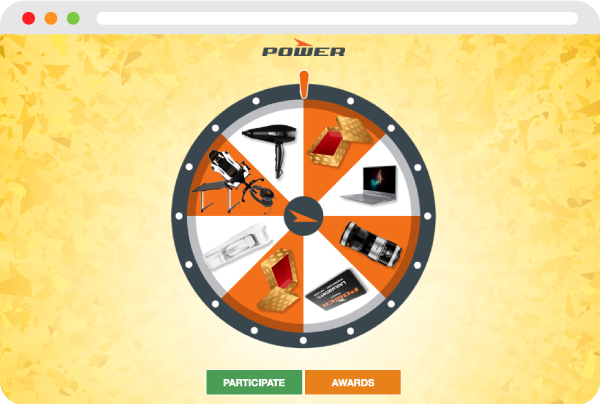
Use cases across industries:
E-Commerce: POWER’s Black Friday Gamification
POWER, a major electronics retailer in Scandinavia, incorporated a Spin the Wheel during their Black Friday sales. This gamified experience turned casual visitors into active participants by offering them chances to win prizes and exclusive discounts. The result was 45,697 new members joining their MyPower loyalty program.
Retail: BOBO’s Spin the Wheel Campaign
BOBO, an online furniture retailer, ran a Spin the Wheel campaign offering gift cards and consolation prizes. The campaign attracted over 6,800 unique participants and achieved a cost per lead as low as €0.18, successfully gathering valuable customer data while keeping acquisition costs down.
Consumer Goods: Rascals Brewing Campaign
Rascals Brewing Company used a Spin the Wheel to engage their audience and boost brand loyalty. The campaign encouraged participants to spin for prizes and discounts, creating excitement around the brand. As a result, Rascals achieved a return on investment of 259%.
B2B: Nova Vista’s Retail Activation Gamification
Nova Vista, a Norwegian marketing agency, specializes in gamified retail activation campaigns for brands. By integrating Spin-the-Wheel games into retail marketing efforts, they helped their clients increase customer engagement and drive in-store visits. This interactive approach turned typical retail promotions into memorable brand experiences, resulting in a crazy 89% conversion rate.
Technical description of settings and configurations:
Creating a Spin the Wheel game in Scratcher is a straightforward process that allows you to design a fully branded, interactive experience in just a few steps.
Start by adding a Game Page to your campaign and selecting the Spin the Wheel format. Once placed, choose a layout that fits your campaign. You can pick from existing templates or create a new one from scratch to match your brand identity.
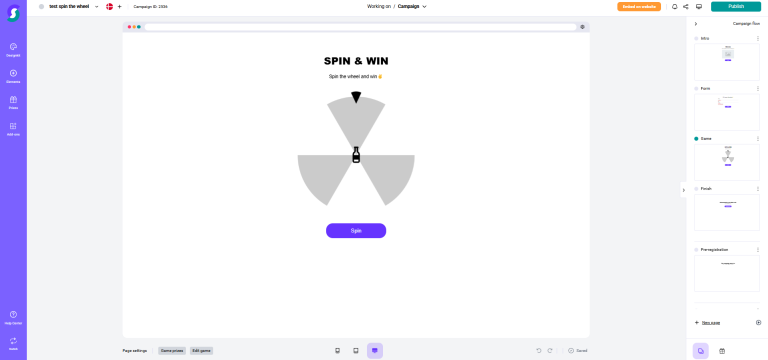
Before designing the wheel itself, make sure to set up your prizes. Each slice of the wheel must link to a prize, so these need to be created in advance. You can assign different probabilities to each prize, ensuring a balance between excitement and achievability.
Now, move on to customizing the wheel. You can decide how many slices you want—between 4 and 8—and design the wheel in two ways: either by uploading a custom image or using Scratcher’s built-in editor. Once your visual is ready, assign each prize to a slice. Optionally, you can add a center image to the wheel and choose whether it should rotate along with it.
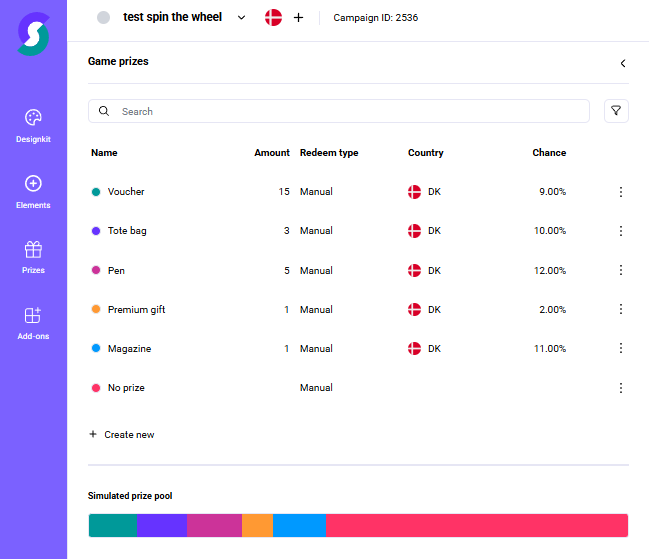
The pointer—or tab—at the top of the wheel can be toggled on or off. If you enable it, you can adjust its size, color, and placement or upload your own image for it. These small details help ensure the visual style fits seamlessly with your brand.
To collect valuable user data and enhance engagement, Scratcher allows you to add a form to your Spin the Wheel game. This feature lets players enter their email address before or after spinning, making it easy to gather leads while keeping the experience fun and interactive. The form is fully customizable, allowing you to match it to your brand’s design and messaging. You can adjust required fields and include consent checkboxes.
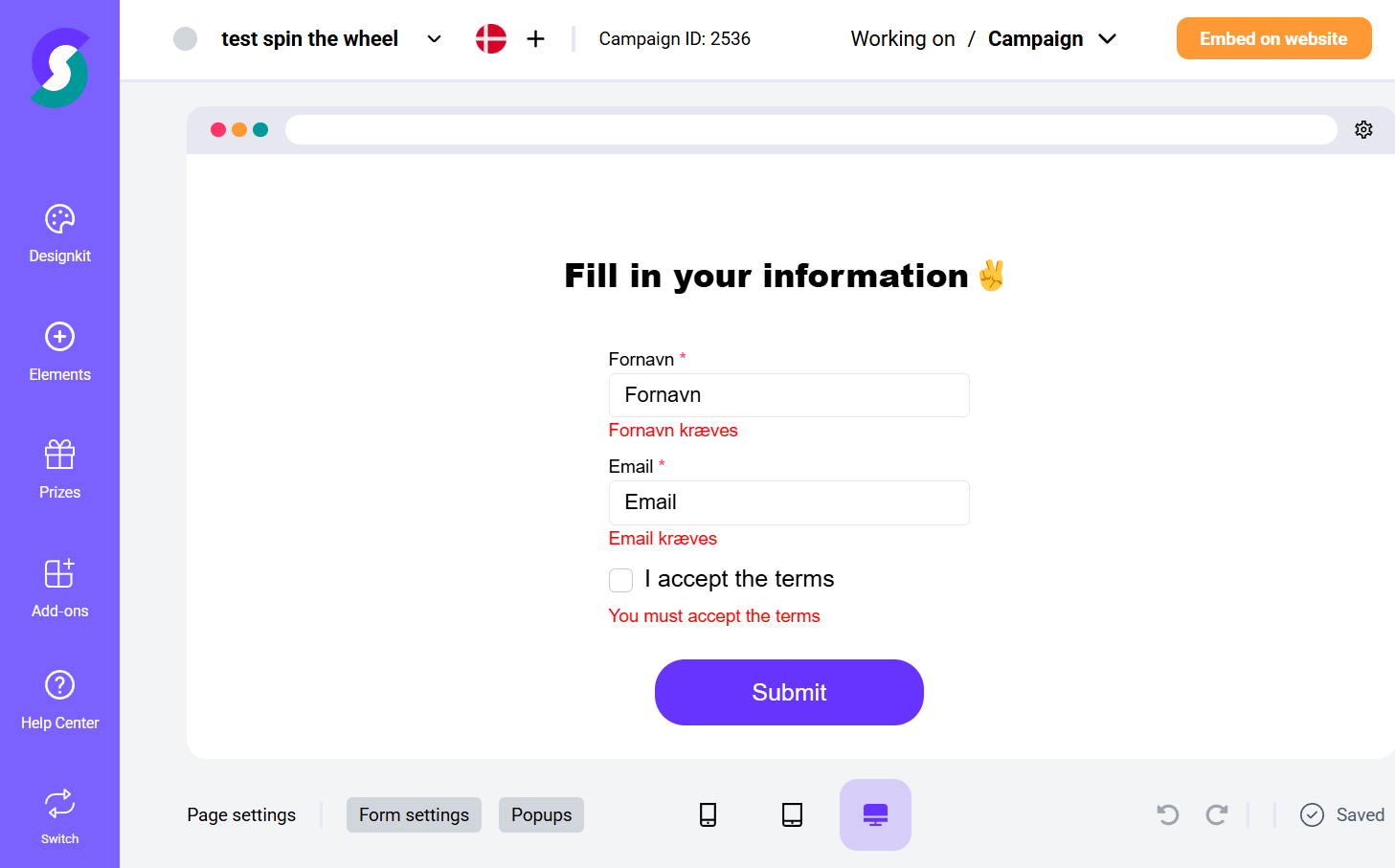
Under settings, select “Advanced”, this allows you to control how the wheel spins: set the spin direction, fine-tune the rotation offset, and configure what happens when someone lands on “Try Again.” You can also adjust the appearance and frequency of this message.
To enhance the experience further, you can add visual and audio effects. Choose from a variety of animations and customize the timing of transitions. You can also upload audio files to play when the wheel starts or stops spinning, adding an extra layer of engagement.
Finally, for more advanced use cases, Scratcher allows the addition of custom CSS and JavaScript event listeners. These options give developers the flexibility to align the game’s behavior with external systems or more complex user journeys.
Once you’re satisfied with your setup, continue building the rest of the campaign flow. Add entry forms, thank-you pages, or follow-up content—and your Spin the Wheel game is ready to go live.
Implementation strategies:
On-Page Integration:
Embedding the game directly into high-conversion landing pages or product pages is straightforward. Typically, you’d insert a snippet of code or use an integration plugin that loads the game smoothly without hampering site performance. By positioning the game at strategic points within your site, you leverage the user’s natural browsing flow for enhanced lead capture and brand interaction.
Integration with Broader Marketing Ecosystem:
Beyond the initial embed and pop-up experience, the game’s design should align with your overall digital strategy. This includes integration with existing analytics tools, synchronization with CRM systems, and adaptive A/B testing to fine-tune visual and functional settings. This strategy ensures that your technical implementation delivers long-term growth and measurable returns.
Gamified Pop-Ups:
Complement your on-page experience with gamified pop-ups that trigger based on specific user behaviors—such as exit intent, scroll thresholds, or time-based delays. A well-timed pop-up can significantly boost user interaction when it’s both visually enticing and directly integrated with your lead-generation strategy.
Ready to level up your engagement strategy?
Explore gamification marketing to create personalised experiences, increase engagement, boost sales, and establish meaningful connections with your audience. With Scratcher as a partner you will have:
- 35+ Games & Interactive Formats: Luck-based, knowledge-based, and skill-based, designed to meet marketing campaign objectives
- Ready to Use Templates: Personalise your campaign to reflect your unique brand
- Native Integration to CRM and CDPs: Easily integrate interactive content with all of your favourite marketing tools
- Customer Support: We're here to assist you every step of the way


